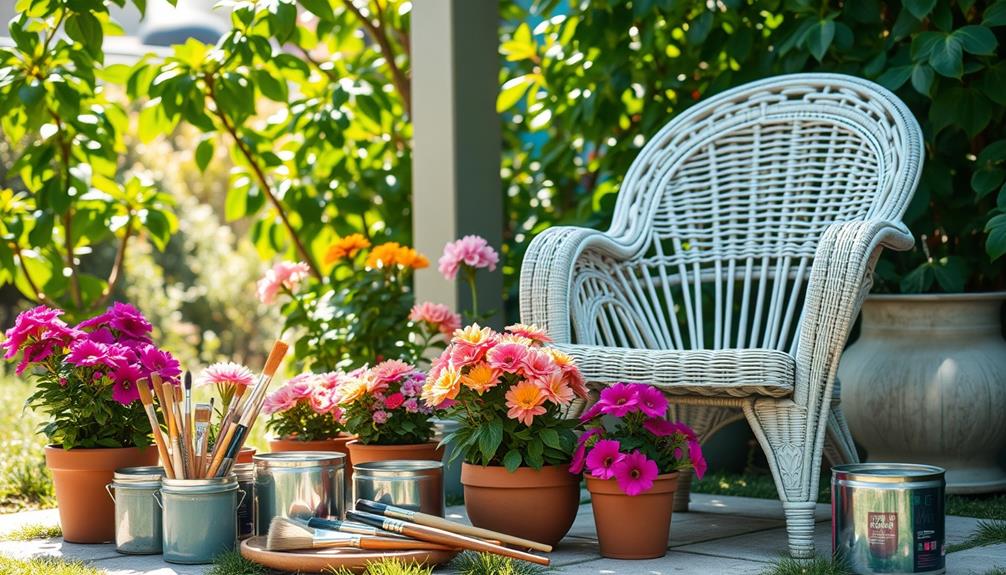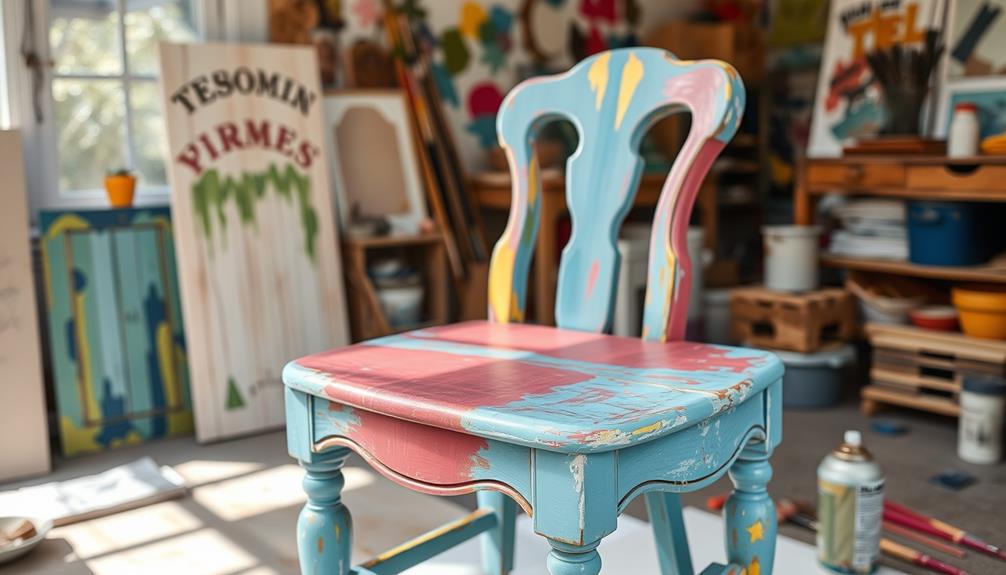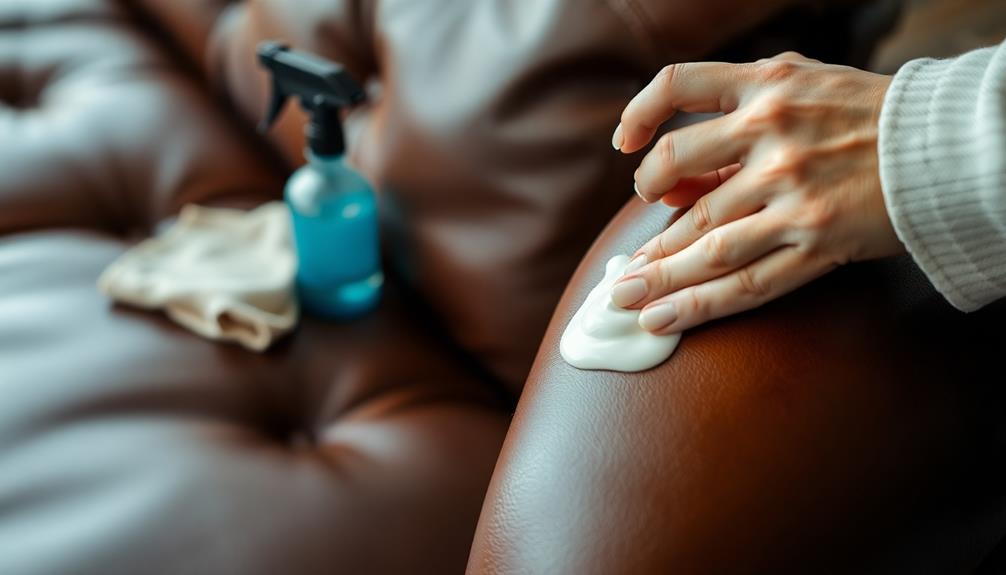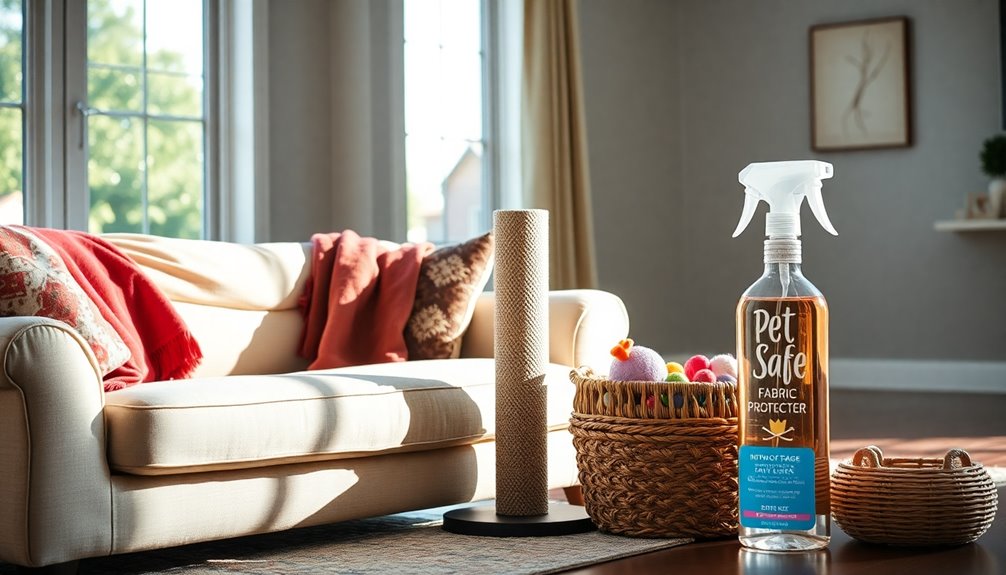Rephrased text:
Refreshing the look of your wicker furniture is a simple and budget-friendly project. Begin by thoroughly cleaning your wicker with a stiff bristle brush, then rinsing it and letting it dry completely. Use a liquid deglosser to help the paint stick better. Apply a light coat of primer and allow it to dry for about an hour. When it comes to painting, opt for high-quality outdoor acrylic spray paint, applying two light coats from an 8-10 inch distance and letting each coat dry before adding another. Lastly, finish off with clear furniture wax to enhance durability. For more tips on preparing and giving the finishing touches, check out additional suggestions. To achieve a distressed or vintage look, try utilizing chalk paint techniques for furniture. This paint technique can provide a unique texture and finish to your wicker pieces, giving them a fashionable and modern appearance. Experiment with different colors and layering techniques to achieve your desired look, and don’t be afraid to let your creativity shine through in your designs. With the right supplies and techniques, you can easily transform your wicker furniture and give it a fresh new style.
Key Takeaways
- Thoroughly clean the wicker furniture using a stiff bristle brush and soapy water, then let it dry completely before painting.
- Use a liquid deglosser to enhance paint adhesion by removing the glossy finish for better coverage.
- Apply a light coat of primer and allow it to dry for at least one hour before proceeding with the paint.
- Spray paint in light coats from an 8-10 inch distance, allowing each coat to dry before applying the next.
- Finish with clear furniture wax for added durability and consider decorative elements to enhance the overall look.
Project Overview
When you're looking to breathe new life into your wicker furniture, painting it can be a rewarding project. Not only is it cost-effective—typically ranging between $15-25—but it also allows you to customize the look of your pieces.
Additionally, guaranteeing that your project area is free from dust and debris, similar to how you'd choose the best vacuums for dust removal in 2024, can help achieve a smoother finish. In total, you can expect to spend about a day on this project, with roughly two hours dedicated to the actual painting.
Proper preparation is vital for a successful outcome. Start by thoroughly cleaning and drying your wicker to make sure that the paint adheres well.
Once you've prepped your furniture, you can choose to use a paint sprayer for an even application, but a brush works just as well. It's important to apply a minimum of two coats of paint for ideal coverage, allowing the first coat to dry completely before adding the second.
This technique not only enhances the appearance but also contributes to a more durable finish that can withstand outdoor conditions.
Necessary Supplies
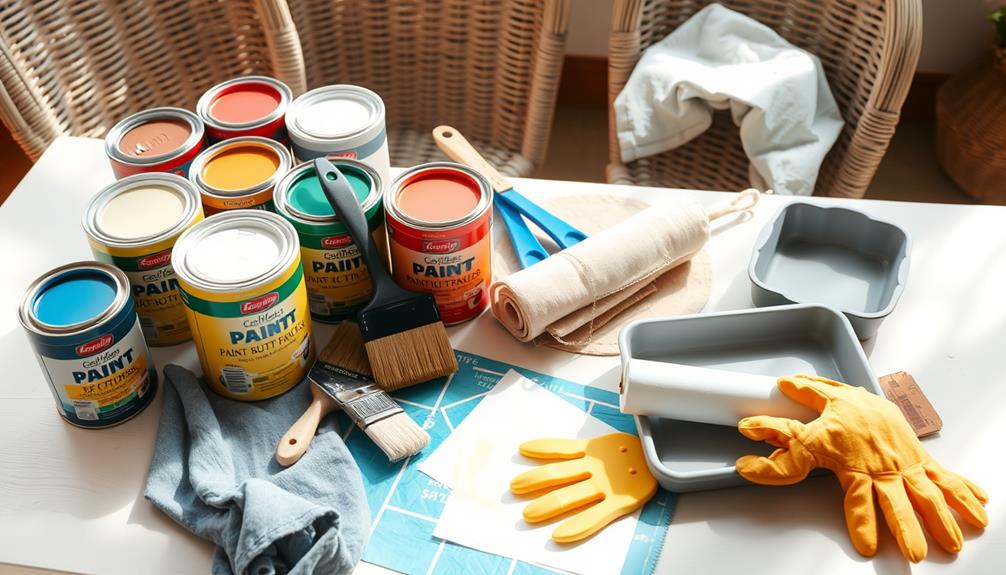
Before you start painting your wicker furniture, it's important to gather all the necessary supplies to guarantee a smooth process. First, get a drop cloth to protect your surfaces from any paint drips. You'll also need a stiff bristle brush to clean the wicker thoroughly and a sponge for applying soapy water. This prep work makes a huge difference in the final result.
Additionally, making certain good air quality in your workspace can enhance the painting experience, as air purifiers improve overall air quality.
Next, grab a liquid deglosser to prepare the surface for painting. This step helps make certain better paint adhesion and a smoother finish. For the actual painting, choose high-quality outdoor acrylic spray paint in your desired paint color; it's perfect for wicker and designed to withstand various weather conditions.
If you want an even better finish, consider using a spray paint primer like KILZ® Primer to enhance paint adherence, allowing for 2-3 light coats.
Lastly, don't forget to wear protective gear. Safety goggles and a respirator mask are essential to keep you safe from fumes and dust while you work.
With these supplies at hand, you'll be ready to transform your wicker furniture!
Preparing the Workspace
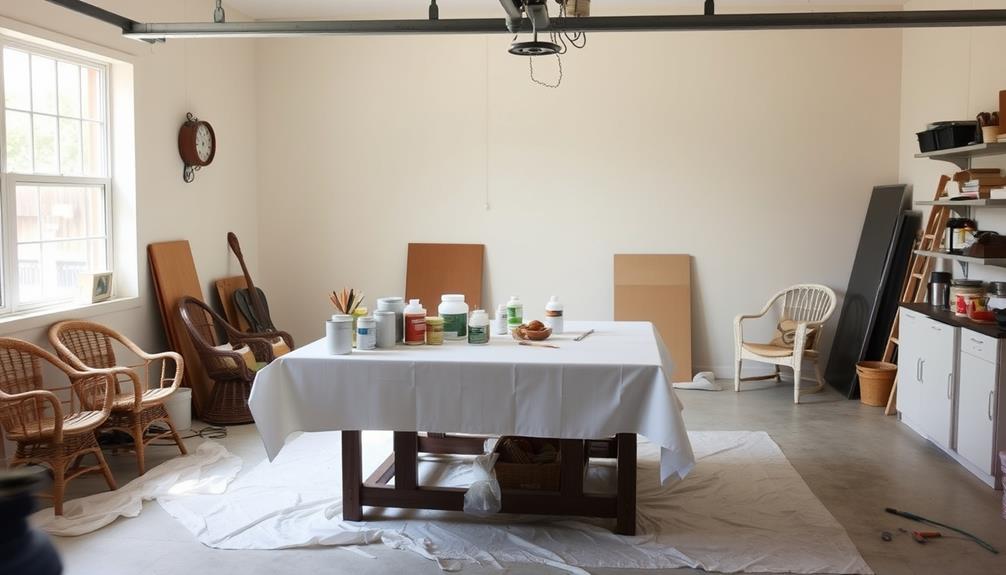
When you're ready to paint your wicker furniture, start by choosing a well-ventilated outdoor location on a clear day.
It's also a good idea to protect your surfaces from paint splatter by using drop cloths or old newspapers.
Make certain to gather your essential safety gear and keep your workspace organized to streamline the process.
This setup not only protects your surfaces but also guarantees a smooth painting experience, similar to how preventing cross-contact is essential in kitchens for a safe environment.
Choosing Outdoor Location
Choosing the right outdoor location for painting your wicker furniture is essential for achieving the finest results. Start by selecting a well-ventilated outdoor area. This minimizes inhalation of paint fumes and guarantees a safe environment. Aim for a clear, calm day with warm temperatures. Such conditions facilitate ideal drying, preventing paint from running due to wind or rain.
Before you begin, lay down drop cloths to protect the ground and any surrounding surfaces from paint drips and overspray. This not only keeps your workspace clean but also helps avoid any potential mess that could be a hassle to clean later.
Make sure you maintain a distance of at least 10 feet from structures like houses to avoid unintended overspray on surfaces that shouldn't be painted.
If possible, set up your workspace in a shaded area. This will prevent the paint from drying too quickly under direct sunlight, which can lead to uneven finishes.
Essential Safety Gear
Preparing your workspace for painting wicker furniture requires attention to safety gear. First, always wear safety goggles to protect your eyes from paint splatters and debris. This simple step can prevent painful accidents that might otherwise ruin your project.
Next, invest in a respirator mask, especially if you're using spray paint or solvents. It filters out harmful fumes, ensuring you can breathe safely while you work.
Selecting a well-ventilated workspace is essential. Ideally, choose an outdoor area or a garage with open windows to minimize inhaling paint fumes. This not only keeps you safe but also helps the paint dry more effectively.
Don't forget about protective clothing! Wear an apron or old clothes that you don't mind getting stained. This will save your skin and everyday attire from unwanted paint marks.
Workspace Organization Tips
Creating an organized workspace is essential for a smooth painting process. By following a few workspace organization tips, you can enhance your efficiency and keep your project on track. First, lay down drop cloths to protect your floors and surroundings, guaranteeing a clean workspace free from paint drips and overspray. Organize all necessary supplies, like paint, brushes, and cleaning materials, within easy reach.
Here's a simple table to help you visualize your workspace setup:
| Area | Purpose |
|---|---|
| Drop Cloths | Protects floor and surrounding areas |
| Supply Station | Houses all necessary supplies |
| Ventilation Zone | Guarantees safety by minimizing fumes |
| Drying Area | Allows painted items to cure properly |
Set up your workspace in a well-ventilated area to minimize inhalation of fumes. Keep tools like spray cans or brushes in designated spots to prevent clutter and maintain an efficient workflow. By organizing your space effectively, you're setting yourself up for success in painting your wicker furniture!
Cleaning the Furniture
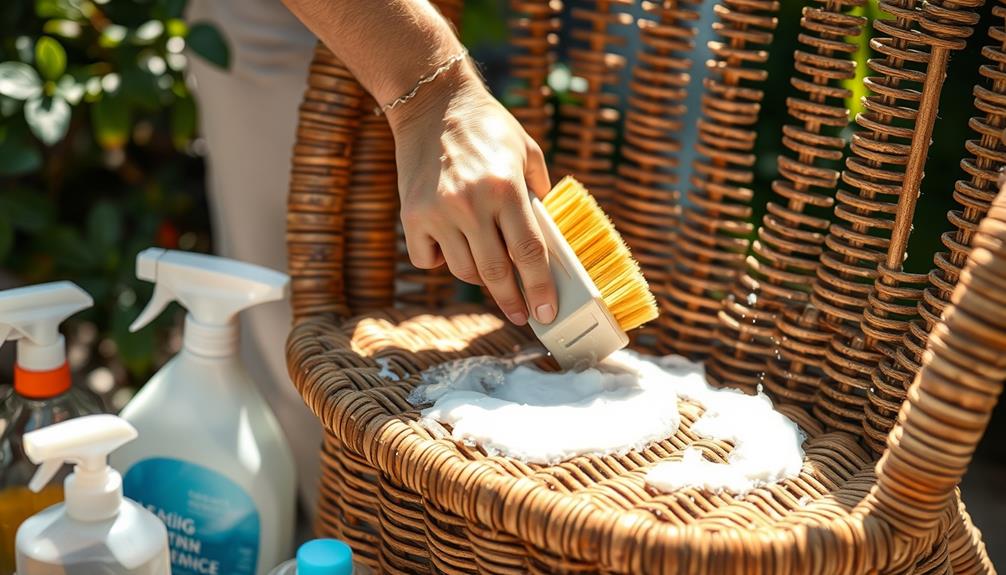
To get your wicker furniture ready for painting, start by removing any dust and debris with a stiff bristle brush.
Next, apply a soapy water solution using a sponge to clean the surface thoroughly.
Dust and Debris Removal
How can you guarantee your wicker furniture is ready for a fresh coat of paint? Start by tackling the dust and debris that's accumulated over time.
Grab a stiff bristle brush to effectively remove cobwebs and dirt from the crevices. This step is vital to make sure nothing interferes with the paint adhesion later on.
Once you've brushed off the loose debris, it's time to vacuum the furniture. This will help eliminate any remaining dust that could affect how well the paint sticks.
After vacuuming, you might still notice some grime, so it's important to clean the wicker surface thoroughly.
Using a sponge, apply a mixture of liquid soap and water to wipe down the furniture. This extra cleaning will guarantee that you have a smooth surface, setting the stage for peak paint adhesion.
Applying Soapy Water
After ensuring your wicker furniture is free of dust and debris, it's time to clean it thoroughly with soapy water. This step is vital for best paint adhesion, as any leftover dirt could compromise your finish.
Start by mixing liquid soap with water in a bucket to create a soapy solution.
Next, grab a sponge and apply the soapy water to the wicker, making sure to get into all the crevices. This will help remove any dirt and grime effectively.
Here are a few tips to keep in mind during the cleaning process:
- Use a soft sponge to avoid damaging the wicker.
- Focus on areas that seem particularly dirty or stained.
- Rinse the furniture well with clean water to eliminate soap residue.
- Allow the wicker to dry completely, ideally overnight.
- Check for any missed spots before moving on to painting.
Thorough cleaning with soapy water is essential for achieving a smooth and durable finish.
Once dry, your wicker furniture will be ready for its fresh coat of paint!
Deglosser for Adhesion
Applying a liquid deglosser is an important step in preparing your wicker furniture for painting, as it enhances paint adhesion by removing the glossy finish left by previous coatings. Start by choosing a deglosser that suits your project and follow the manufacturer's instructions for application.
You'll want to guarantee even coverage over the entire surface of the wicker to facilitate better paint bonding. Once you've applied the deglosser, take a clean rag and wipe the surface to remove any residue. This step is essential for achieving a smooth, clean base for your paint.
Make sure to allow the deglosser to dry completely. Skipping this step can compromise the adhesion of the paint, leading to an uneven finish. Proper deglossing is critical not just for the immediate paint application but also for the longevity of your finished product.
A well-prepared surface greatly reduces the risk of chipping and peeling, making certain your newly painted wicker furniture looks great for years to come. Taking the time to degloss properly will pay off in the long run, so don't overlook this important step!
Priming and Painting

Wicker furniture's unique texture requires a careful approach to priming and painting for the best results. Start by applying a light coat of primer, such as KILZ® ORIGINAL Oil-Based Primer. Let it dry for at least one hour before adding any additional coats. This step is vital for ideal coverage.
Next, choose a spray paint that's compatible with wicker, like Behr chalk spray paint. Follow these tips for applying the paint:
- Maintain a distance of 8-10 inches from the surface for even application.
- Use a sweeping motion while spraying to cover all crevices and edges effectively.
- Vary the angle of application to achieve consistent coverage.
- Apply two light coats to guarantee a smooth finish.
- Allow each coat to dry completely—typically about an hour—before handling.
These steps will help you achieve a professional look.
Drying and Curing
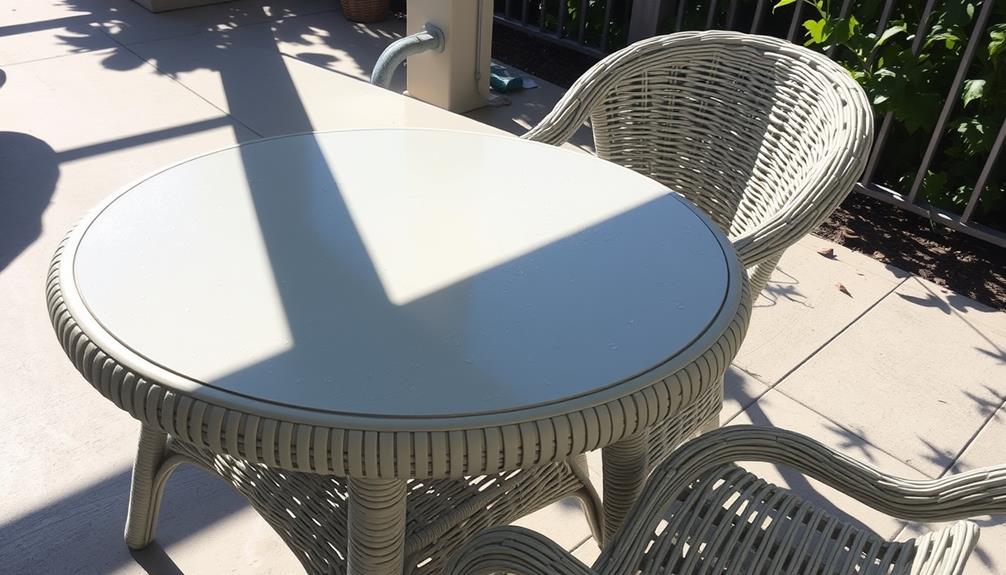
Your freshly painted wicker furniture needs careful attention during the drying and curing process to assure a durable finish. After applying your first coat of paint, allow it to dry for at least one hour before adding a second coat. This guarantees ideal coverage and consistency. Once you've finished painting, wait a minimum of 24 hours for the paint to dry fully before using the furniture.
It's important to remember that full curing of the paint can take up to two weeks. During this time, the paint continues to harden and bond with the wicker surface. Always check the paint can for specific drying and curing recommendations, as different products may have varying requirements.
To help you manage the drying and curing stages, refer to the table below:
| Process | Time Required |
|---|---|
| First Coat Drying | 1 hour |
| Second Coat Application | After 1 hour |
| Minimum Drying Time | 24 hours |
| Full Curing Time | Up to 2 weeks |
| Inspection for Touch-ups | After drying |
Inspect the painted wicker from multiple angles to identify any uneven finishes that may need touch-ups.
Finishing Touches
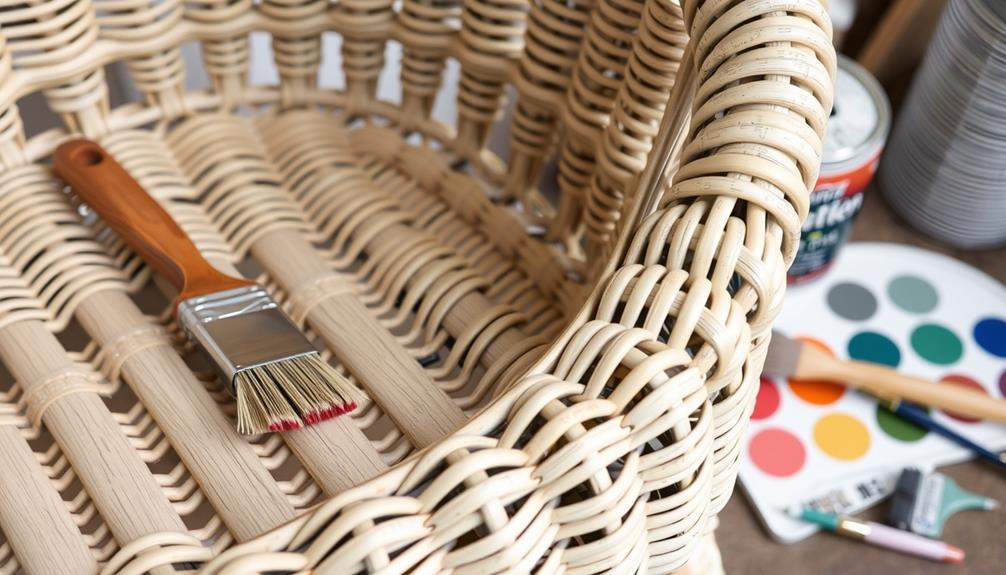
Once the paint has fully cured, it's time to add those finishing touches that can truly elevate your wicker furniture.
These steps will enhance your paint job and give your pieces a fresh, new look.
- Apply Clear Furniture Wax: Use a product like FAT Paint Clear Furniture Wax to protect the finish and increase durability. Allow it to cure for a few days for peak performance.
- Evaluate the Overall Look: Step back and assess your painted wicker. Make any necessary adjustments to guarantee a polished appearance.
- Add Decorative Elements: Incorporate cushions or throws to boost comfort and style. These additions can transform your furniture into a cozy oasis.
- Upgrade Hardware: Consider replacing old knobs or handles with new ones. This small change can greatly elevate the overall appearance of your furniture.
- Inspect for Imperfections: Check the painted surface for any uneven finishes or missed spots. Touch up these areas to guarantee a flawless final look.
Benefits of Painting Wicker
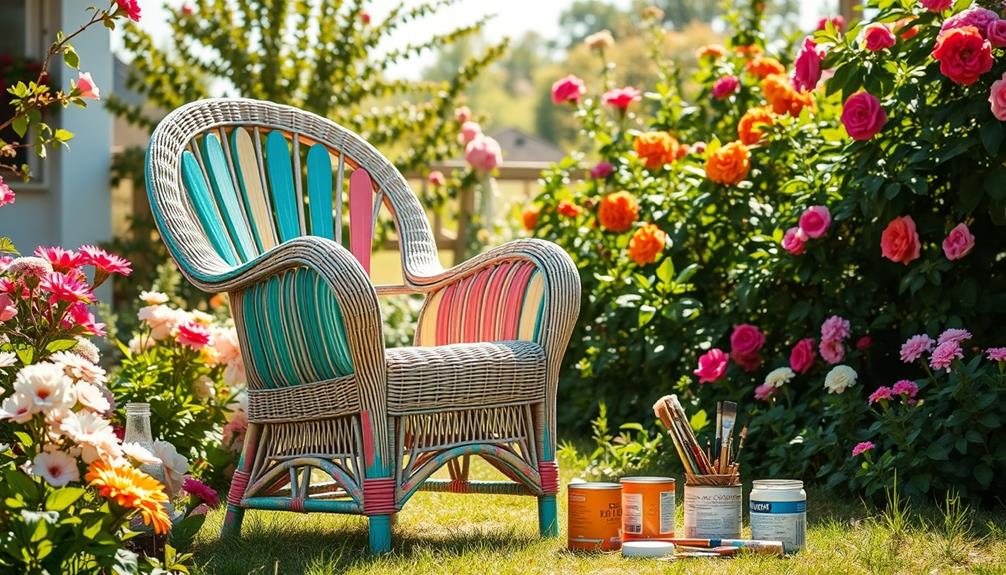
Painting wicker furniture offers a multitude of benefits that can transform your living space without breaking the bank. When you choose to paint, you're not only saving money—typically around $15 versus the $500 or more for new wicker furniture—but you're also customizing old pieces to reflect your personal style.
A new coat of paint in a new color, like Robins Egg Blue or deep blue, can enhance the overall aesthetic of any room. Light colors can brighten up your space, making it feel more open and inviting, while seamlessly complementing your existing decor.
Another significant advantage is the durability of painted wicker furniture; with proper care, it can last for years, even when used outdoors. This durability makes it a long-term investment in your home decor.
Moreover, upcycling old wicker furniture contributes to sustainable practices by reducing waste and promoting creative reuse. By painting your wicker, you're not just revitalizing your space; you're also making an eco-friendly choice.
Embrace the benefits of painting wicker, and enjoy a stylish, personalized, and sustainable living environment.
Frequently Asked Questions
What Kind of Paint Do You Use on Wicker Furniture?
You'll want to use outdoor acrylic spray paint for its durability and color. Chalk-style paint also works well for better adhesion. Don't forget to apply a primer for best results before painting your wicker furniture!
Do I Need to Prime Wicker Before Painting?
Yes, you should prime wicker before painting. It guarantees better paint adhesion, smoother coverage, and minimizes chipping. Applying 2-3 light coats of primer will enhance durability and give your project a professional finish.
How Do You Get Paint to Stick to Wicker?
Did you know that 70% of paint failures occur due to improper surface preparation? To get paint to stick to wicker, clean it thoroughly, use a deglosser, and apply a primer before painting for ideal adhesion.
How to Change the Color of Wicker?
To change the color of wicker, clean it thoroughly with a stiff brush and soapy sponge. Then, use a liquid deglosser, apply spray primer, and finish with light coats of outdoor acrylic spray paint.
Conclusion
Now that you've transformed your wicker furniture with fresh paint, just imagine how it'll look in your space! But wait—don't rush to put it back just yet. Let it cure fully for the best results. Once you see the vibrant colors pop and the texture shine, you'll realize the effort was worth it. What will your new décor say about you? Immerse yourself in this exciting change, and soon, you might just be the envy of your friends!
